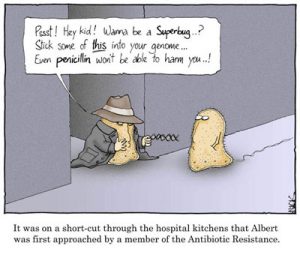My first 4-H animal, Frosty, was a pretty heifer with a robust constitution and a feisty disposition. She had calves each year and never once came down with mastitis or any other infection that required antibiotic treatment.
I was not quite so feisty or robust as Frosty. More than once, antibiotics rescued me from childhood bouts with serious cases of strep throat.
I am sure each of you has vivid memories of the almost miraculous effects of antibiotics in your own life. These “wonder drugs” are indispensable to doctors and to veterinarians. This is why we need strong, common-sense rules to ensure they are used similarly in both humans and livestock—only when absolutely necessary to treat disease.
The Food and Drug Administration (FDA) has the power and the responsibility to require such common sense rules. Instead, they came out with a weak baby step toward controlling the rampant and routine use of antibiotics in animal feed. The FDA meekly requested that drug companies voluntarily revise the labels on some of their antibiotics, removing the indication that antibiotics can be used to promote growth in livestock.
Yes, a few words may be taken off the drug labels, but nothing significant will change – certainly not the amount of antibiotics used in animal feed (roughly 80% of all antibiotics used in the U.S.), or the drug companies’ bottom line, or the increasing risk that you will get infected with bacteria that have become resistant to antibiotics because of their indiscriminate use in livestock facilities.
The reason that nothing will change when “growth promotion” is taken off drug labels is that the labels will continue to state that the drugs may be used “to treat, control, or prevent disease in animals.”
This is like saying to your alcoholic friend, “I know you want to quit drinking, so I’m going to only let you have water, apple juice, or vodka.”
Allowing a farmer or veterinarian to choose the unacceptable preventative use of antibiotics is like allowing your friend to choose the unacceptable drink, vodka. Both choices are just plain wrong.

Did you add a few drops of penicillin to the bottle each feeding time to prevent your baby from getting a sore throat? Or sprinkle a little tetracycline on your toddler’s corn flakes every morning to avert earaches?I suspect not, and you don’t have to be a microbiologist to know why: when a person or animal uses antibiotics routinely, the only bacteria that can survive and reproduce are the resistant ones, often termed “super-bugs.” The sensible use of antibiotics, therefore, is not routine use to prevent disease, but targeted use to treat it.
Although disease prevention is most emphatically not a valid use for antibiotics, it is the back door that the FDA leaves wide open for the continued routine feeding of sub-therapeutic levels of antibiotics. With a “nudge, nudge, wink, wink,” the outlawed growth-promotion use becomes the allowed disease-prevention use, and business as usual continues for the CAFOs and the drug companies.
Call it what you will, the routine, non-therapeutic use of antibiotics in livestock is swiftly leading us to the day when we will be unable to treat animal or human bacterial diseases with one of the greatest medicines ever created. The Centers for Disease Control and Prevention conservatively estimates that 23,000 Americans die of illnesses related to antibiotic-resistant bacteria each year. Another two million become seriously ill.
It’s time for all of us to let the FDA know they need to live up to their motto: “Protecting and promoting your health.” They work for us, not for drug companies, and their job is to ensure that our “wonder drugs” remain powerful weapons that continue to work the next time my cow Frosty’s offspring have a respiratory infection, or my friend’s goats get mastitis, or your child comes down with strep throat.
Here are some ways you can make your voice heard, and here are some additional articles exploring the topic:
New York Times article and Mark Bittman’s column


